Paper Menu >>
Journal Menu >>
 Applied Mathematics, 2010, 1, 326-333 doi:10.4236/am.2010.14043 Published Online October 2010 (http://www.SciRP.org/journal/am) Copyright © 2010 SciRes. AM Effect of Non-Homogeneity on Thermally Induced Vibration of Orthotropic Visco-Elastic Rectangular Plate of Linearly Varying Thickness Arun Kumar Gupta, Pooja Singhal Department of Mathematics, M.S. College, Saharanpur, Uttar Pradesh, India E-mail: gupta_arunnitin@yahoo.co.in, poojaacad@yahoo.in Received August 3, 2010; revised August 30, 2010; accepted September 3, 2010 Abstract The analysis presented here is to study the effect of non-homogeneity on thermally induced vibration of orthotropic visco-elastic rectangular plate of linearly varying thickness. Thermal vibrational behavior of non -homogeneous rectangular plates of variable thickness having clamped boundary conditions on all the four edges is studied. For non-homogeneity of the plate material, density is assumed to vary linearly in one direc- tion. Using the method of separation of variables, the governing differential equation is solved. An approxi- mate but quite convenient frequency equation is derived by using Rayleigh-Ritz technique with a two-term deflection function. Time period and deflection at different points for the first two modes of vibration are calculated for various values of temperature gradients, non-homogeneity constant, taper constant and aspect ratio. Comparison studies have been carried out with non-homogeneous visco-elastic rectangular plate to establish the accuracy and versatility. Keywords: Non-Homogeneous, Orthotropic, Visco-Elastic, Variable Thickness, Rectangular Plate, Vibration, Thermal Gradient 1. Introduction Thermal effect on vibration of non-homogenous viscoe- lastic plates are of great interest in the field of engineer- ing such as for better designing of gas turbines, jet en- gine, space craft and nuclear power projects, where met- als and their alloys exhibits visco-elastic behavior. There- fore, for these reason such structures are exposed to high intensity heat fluxes and thus material properties undergo significant changes, in particular the thermal effect on the modules of elasticity of the material can not be taken as negligible. Plates of variable thickness have been extensively used in Civil, Electronic, Mechanical, Aerospace and Marine Engineering applications. The practical importance of such plates has made vibration analysis essential espe- cially since the vibratory response needs to be accurately determined in design process in order to avoid resonance excited by internal or external forces. Visco-elastic, as its name implies, is a generalization of elasticity and viscosity. The ideal linear elastic ele- ment is the spring. When a tensile force is applied to it, the increase in the distance between its two ends is pro- portional to the force. The ideal linear viscous element is the dashpot. The plate type structural components in aircraft and rockets have to operate under elevated temperatures that cause non-homogeneity in the plate material i.e. elastic constants of the materials becomes functions of space variables. In an up-to-date survey of literature, authors have come across various models to account for non-ho- mogeneity of plate materials proposed by researchers dealing with vibration but none of them consider non-ho- mogeneity with thermal effect on orthotropic visco-elastic plates. Free vibration of visco-elastic orthotropic rectangular plates was discussed by Sobotka [1].Gupta and Khanna [2] discussed vibration of viscoelastic rectangular plate with linearly thickness variations in both directions. Leissa’s monograph [3] contains an excellent discussion of the subject of vibrating plates with elastic edge sup- port. Several authors [4,5] have studied the thermal ef- fect on vibration of homogeneous plates of variable thickness but no one considered thermal effect on vibra- 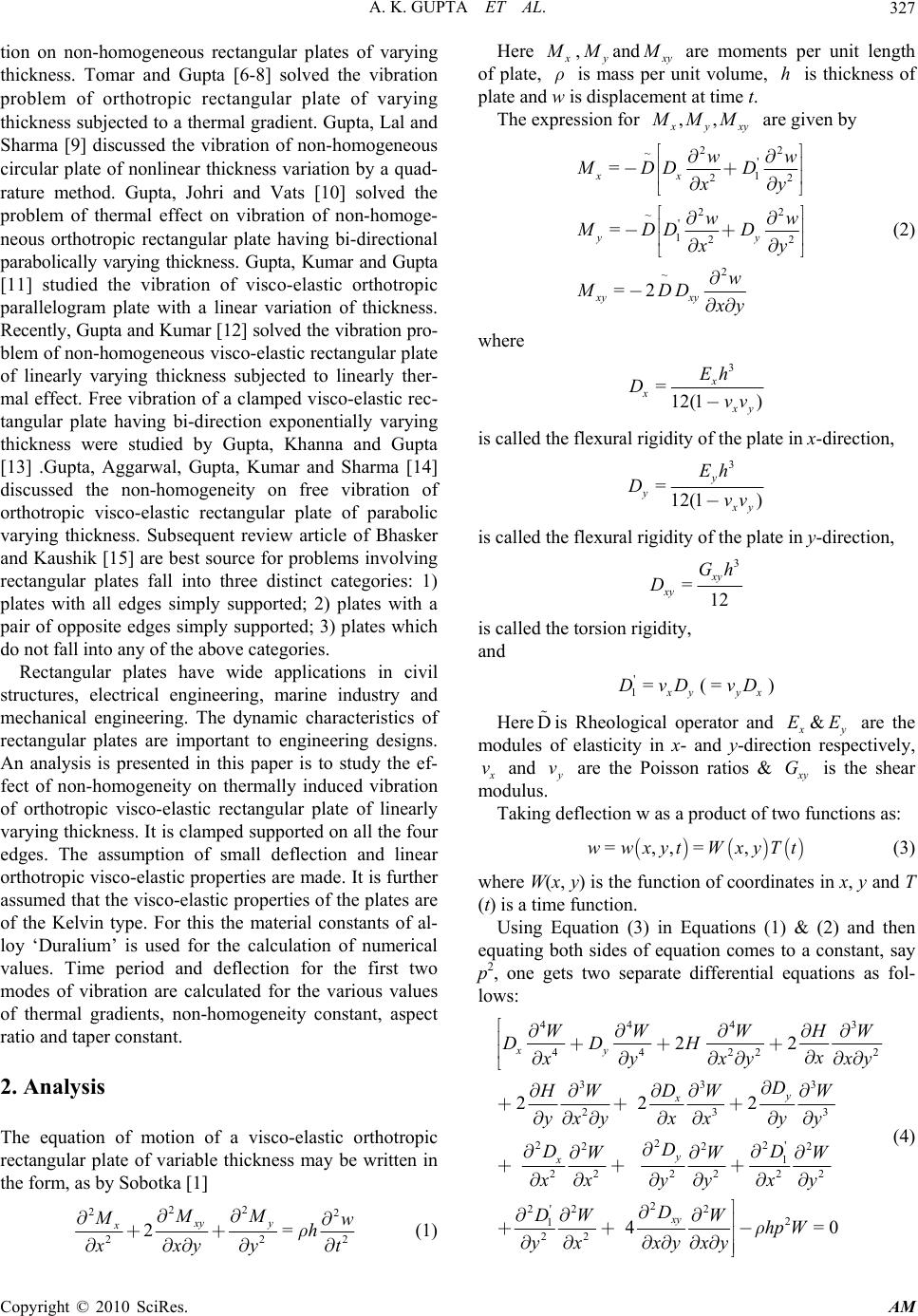 A. K. GUPTA ET AL. Copyright © 2010 SciRes. AM 327 tion on non-homogeneous rectangular plates of varying thickness. Tomar and Gupta [6-8] solved the vibration problem of orthotropic rectangular plate of varying thickness subjected to a thermal gradient. Gupta, Lal and Sharma [9] discussed the vibration of non-homogeneous circular plate of nonlinear thickness variation by a quad- rature method. Gupta, Johri and Vats [10] solved the problem of thermal effect on vibration of non-homoge- neous orthotropic rectangular plate having bi-directional parabolically varying thickness. Gupta, Kumar and Gupta [11] studied the vibration of visco-elastic orthotropic parallelogram plate with a linear variation of thickness. Recently, Gupta and Kumar [12] solved the vibration pro- blem of non-homogeneous visco-elastic rectangular plate of linearly varying thickness subjected to linearly ther- mal effect. Free vibration of a clamped visco-elastic rec- tangular plate having bi-direction exponentially varying thickness were studied by Gupta, Khanna and Gupta [13] .Gupta, Aggarwal, Gupta, Kumar and Sharma [14] discussed the non-homogeneity on free vibration of orthotropic visco-elastic rectangular plate of parabolic varying thickness. Subsequent review article of Bhasker and Kaushik [15] are best source for problems involving rectangular plates fall into three distinct categories: 1) plates with all edges simply supported; 2) plates with a pair of opposite edges simply supported; 3) plates which do not fall into any of the above categories. Rectangular plates have wide applications in civil structures, electrical engineering, marine industry and mechanical engineering. The dynamic characteristics of rectangular plates are important to engineering designs. An analysis is presented in this paper is to study the ef- fect of non-homogeneity on thermally induced vibration of orthotropic visco-elastic rectangular plate of linearly varying thickness. It is clamped supported on all the four edges. The assumption of small deflection and linear orthotropic visco-elastic properties are made. It is further assumed that the visco-elastic properties of the plates are of the Kelvin type. For this the material constants of al- loy ‘Duralium’ is used for the calculation of numerical values. Time period and deflection for the first two modes of vibration are calculated for the various values of thermal gradients, non-homogeneity constant, aspect ratio and taper constant. 2. Analysis The equation of motion of a visco-elastic orthotropic rectangular plate of variable thickness may be written in the form, as by Sobotka [1] 22 22 222 2= xy y xMM Mw h xy x yt r ¶¶ ¶¶ ++ ¶¶ ¶¶¶ (1) Here x M , y M and x y M are moments per unit length of plate, r is mass per unit volume, h is thickness of plate and w is displacement at time t. The expression for ,, x yxy M MM are given by 22 ~' 1 22 22 ~' 122 2 ~ = = =2 xx yy xy xy ww MDD D x y ww MDDD x y w MDD xy é ù ¶¶ ê ú -+ ê ú ¶¶ ë û é ù ¶¶ ê ú -+ ê ú ¶¶ ë û ¶ -¶¶ (2) where 3 =12(1 ) x x x y Eh Dvv- is called the flexural rigidity of the plate in x-direction, 3 =12(1 ) y y x y Eh Dvv - is called the flexural rigidity of the plate in y-direction, 3 =12 xy xy Gh D is called the torsion rigidity, and ' 1=(=) x yyx DvD vD Here D is Rheological operator and & x y EE are the modules of elasticity in x- and y-direction respectively, x ν and y ν are the Poisson ratios & x y G is the shear modulus. Taking deflection w as a product of two functions as: ()()() =,,= ,wwxyt WxyTt (3) where W(x, y) is the function of coordinates in x, y and T (t) is a time function. Using Equation (3) in Equations (1) & (2) and then equating both sides of equation comes to a constant, say p2, one gets two separate differential equations as fol- lows: 44 43 44 222 333 233 2 22' 222 1 2222 22 2 2' 22 2 1 22 22 222 4=0 xy y x y x xy WW WHW DD Hx x yxy xy D D HWW W yxy xy xy D DD WWW xxyy xy D DWW hp W xy xy yx r é ¶¶ ¶¶¶ ê++ + ê¶ ¶¶ ¶¶¶¶ ë ¶ ¶ ¶¶¶ ¶ +++ ¶¶¶ ¶¶ ¶¶ ¶ ¶¶ ¶¶¶ ++ + ¶¶¶¶¶¶ ù ¶ ¶¶¶ ú ++ - ú ¶¶ ¶¶ ¶¶ ú û (4) 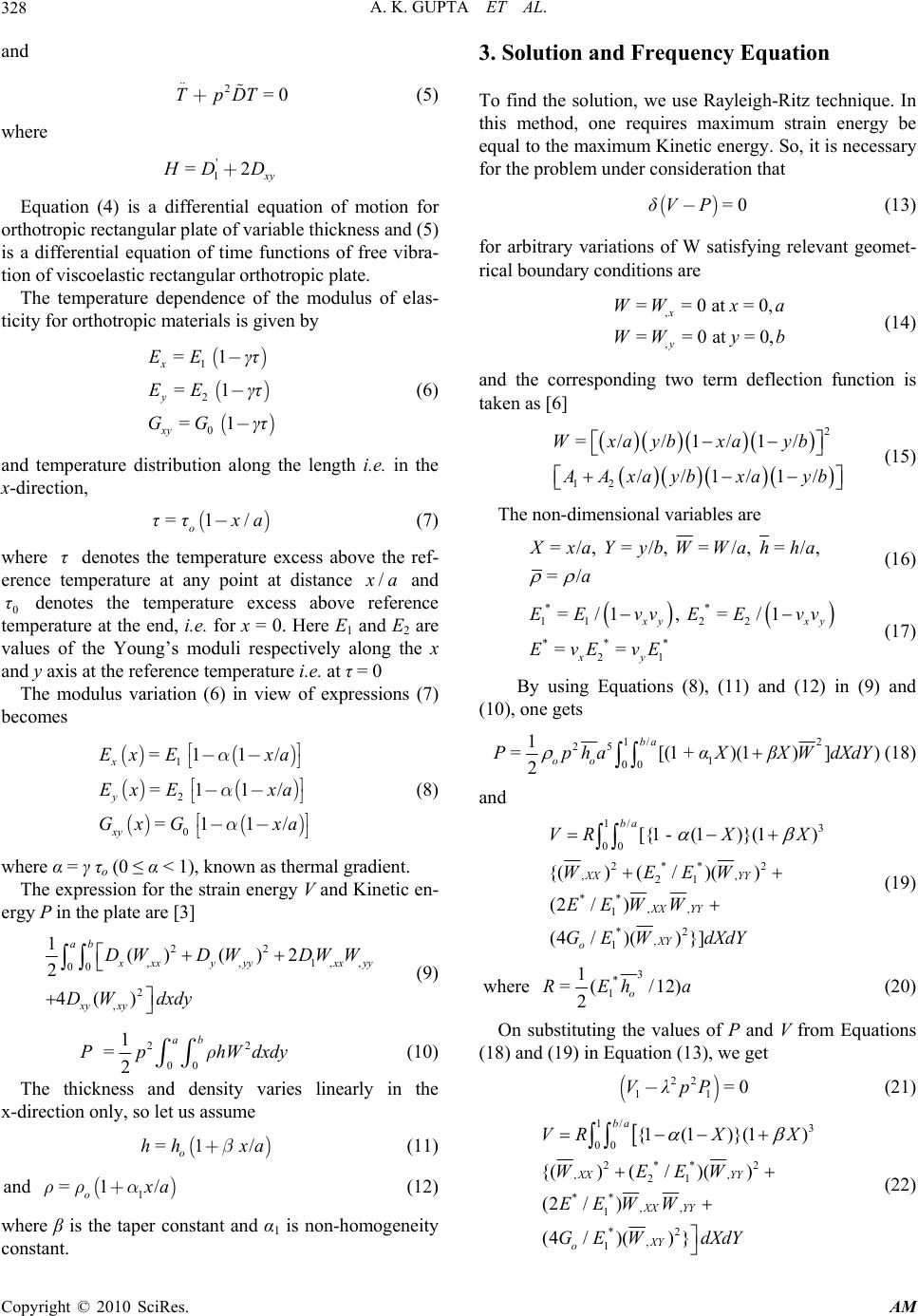 A. K. GUPTA ET AL. Copyright © 2010 SciRes. AM 328 and .. 2=0TpDT+ (5) where ' 1 =2 x y H DD+ Equation (4) is a differential equation of motion for orthotropic rectangular plate of variable thickness and (5) is a differential equation of time functions of free vibra- tion of viscoelastic rectangular orthotropic plate. The temperature dependence of the modulus of elas- ticity for orthotropic materials is given by () () () 1 2 0 =1 =1 =1 x y xy EE γτ EE γτ GG γτ - - - (6) and temperature distribution along the length i.e. in the x-direction, () =1 / o ττ x a- (7) where τ denotes the temperature excess above the ref- erence temperature at any point at distance / x a and 0 τ denotes the temperature excess above reference temperature at the end, i.e. for x = 0. Here E1 and E2 are values of the Young’s moduli respectively along the x and y axis at the reference temperature i.e. at τ = 0 The modulus variation (6) in view of expressions (7) becomes ()( ) ()( ) ()( ) 1 2 0 =1 1/ =1 1/ =11/ x y xy Ex Exa Ex Exa Gx Gxa a a a éù -- ëû éù -- ëû éù -- ëû (8) where α = γ τo (0 ≤ α < 1), known as thermal gradient. The expression for the strain energy V and Kinetic en- ergy P in the plate are [3] 22 ,,1,, 00 2 , 1() ()2 2 4( ) ab x xxyyyxx yy xy xy DW DWDWW D Wdxdy (9) 22 00 1 =2 ab PphWdxdyr òò (10) The thickness and density varies linearly in the x-direction only, so let us assume () =1 / o hh xab+ (11) and () 1 =1 / o x arr a+ (12) where β is the taper constant and α1 is non-homogeneity constant. 3. Solution and Frequency Equation To find the solution, we use Rayleigh-Ritz technique. In this method, one requires maximum strain energy be equal to the maximum Kinetic energy. So, it is necessary for the problem under consideration that () =0δVP- (13) for arbitrary variations of W satisfying relevant geomet- rical boundary conditions are , , ==0 at =0, ==0 at =0, x y WWx a WWyb (14) and the corresponding two term deflection function is taken as [6] 2 12 =/ /1/1/ //1/1/ Wxaybxa yb A Axayb xayb (15) The non-dimensional variables are =/, =/, =/, =/, =/ X xaYybWW ahha a (16) ** 112 2 *** 21 =/1, =/1 == xy xy xy EE νν EE νν EνEνE (17) By using Equations (8), (11) and (12) in (9) and (10), one gets 2 1/ 25 00 1 =[(1 + )(1)]) 2 ba oo Ppha αXβ X WdXdY (18) and 1/ 3 00 2** 2 ,, 21 ** ,, 1 *2 , 1 [{1 - (1)}(1) {() (/)() (2 /) (4/)() }] ba XX YY XX YY XY o VRX X WEEW EEWW GEW dXdY (19) where 3 * 1 1 =( /12) 2o REh a (20) On substituting the values of P and V from Equations (18) and (19) in Equation (13), we get () 22 11 =0VλpP- (21) 1/ 3 00 2** 2 ,, 21 ** ,, 1 *2 , 1 {1(1)}(1) {() (/)() (2 /) (4/)() } ba XX YY XX YY XY o VRX X WEEW EEW W GEW dXdY (22) 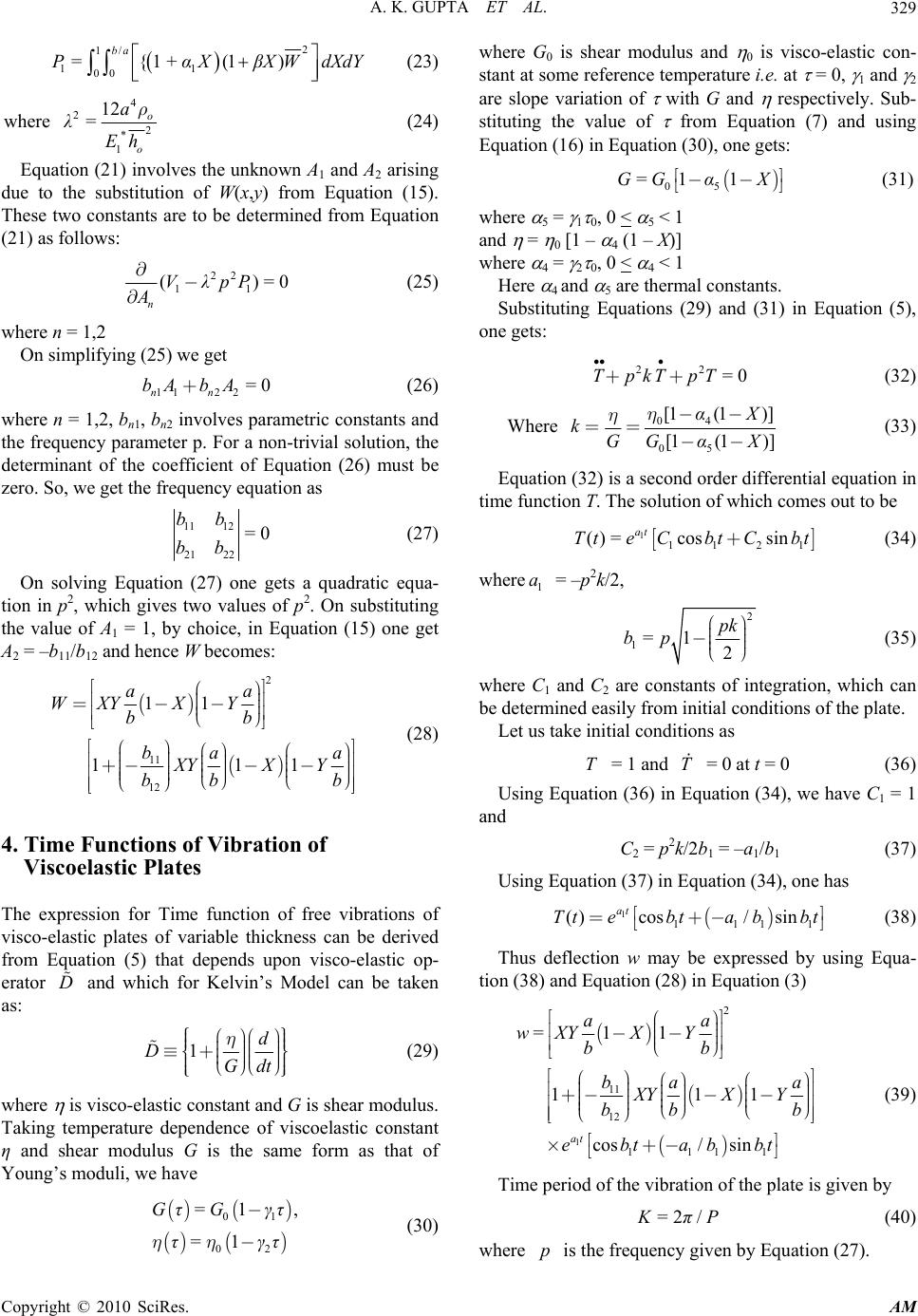 A. K. GUPTA ET AL. Copyright © 2010 SciRes. AM 329 2 1/ 11 00 ={1 + (1) ba PαXβ X WdXdY (23) where 4 2 2 * 1 12 =o o a λ Eh r (24) Equation (21) involves the unknown A1 and A2 arising due to the substitution of W(x,y) from Equation (15). These two constants are to be determined from Equation (21) as follows: 22 11 ()=0 n VλpP A ¶- ¶ (25) where n = 1,2 On simplifying (25) we get 112 2 =0 nn bAbA+ (26) where n = 1,2, bn1, bn2 involves parametric constants and the frequency parameter p. For a non-trivial solution, the determinant of the coefficient of Equation (26) must be zero. So, we get the frequency equation as 11 12 21 22 =0 bb bb (27) On solving Equation (27) one gets a quadratic equa- tion in p2, which gives two values of p2. On substituting the value of A1 = 1, by choice, in Equation (15) one get A2 = –b11/b12 and hence W becomes: () () 2 11 12 11 111 aa WXYX Y bb baa XYX Y bb b éù æö ÷ ç êú =-- ÷ ç÷ ç êú èø ëû éù æö æöæ ö ÷ ç÷÷ êú çç ÷ +-- - ç÷÷ çç ÷÷÷ êú ççç ÷ çèøè ø èø êú ëû (28) 4. Time Functions of Vibration of Viscoelastic Plates The expression for Time function of free vibrations of visco-elastic plates of variable thickness can be derived from Equation (5) that depends upon visco-elastic op- erator D and which for Kelvin’s Model can be taken as: 1d DGdt h ìü æöæö ïï ïï ÷÷ çç º+ ÷÷ íý çç ÷÷ çç ïï èøèø ïï îþ (29) where is visco-elastic constant and G is shear modulus. Taking temperature dependence of viscoelastic constant η and shear modulus G is the same form as that of Young’s moduli, we have () () () () 01 02 =1, =1 GτGγτ τγτhh - - (30) where G0 is shear modulus and 0 is visco-elastic con- stant at some reference temperature i.e. at = 0, 1 and 2 are slope variation of with G and respectively. Sub- stituting the value of from Equation (7) and using Equation (16) in Equation (30), one gets: () 05 =1 1GG α X é ù -- ë û (31) where 5 = 1 0, 0 < 5 < 1 and = 0 [1 – 4 (1 – X)] where 4 = 2 0, 0 < 4 < 1 Here 4 and 5 are thermal constants. Substituting Equations (29) and (31) in Equation (5), one gets: 22 =0TpkTpT ·· · ++ (32) Where 04 05 [1(1 )] [1(1 )] α X kGG α X h h-- == -- (33) Equation (32) is a second order differential equation in time function T. The solution of which comes out to be [ ] 1 1121 ()= cossin at TteCbt Cbt+ (34) where 1 a = –p2k/2, 2 1=1 2 pk bp æö ÷ ç -÷ ç÷ ç èø (35) where C1 and C2 are constants of integration, which can be determined easily from initial conditions of the plate. Let us take initial conditions as T = 1 and T = 0 at t = 0 (36) Using Equation (36) in Equation (34), we have C1 = 1 and C2 = p2k/2b1 = –a1/b1 (37) Using Equation (37) in Equation (34), one has () 1 1111 ()cos/sin at Ttebtabbt é ù =+- ë û (38) Thus deflection w may be expressed by using Equa- tion (38) and Equation (28) in Equation (3) () () () 1 2 11 12 1111 =11 111 cos/sin at aa wXYX Y bb baa XYX Y bb b ebtabbt éù æö ÷ ç êú -- ÷ ç÷ ç êú èø ëû é ù æö æöæ ö ÷ ç÷÷ ê ú çç ÷ +-- - ç÷÷ çç ÷÷÷ ê ú ççç ÷ çèøè ø èø ê ú ë û éù ´+- ë û (39) Time period of the vibration of the plate is given by =2 /KπP (40) where p is the frequency given by Equation (27). 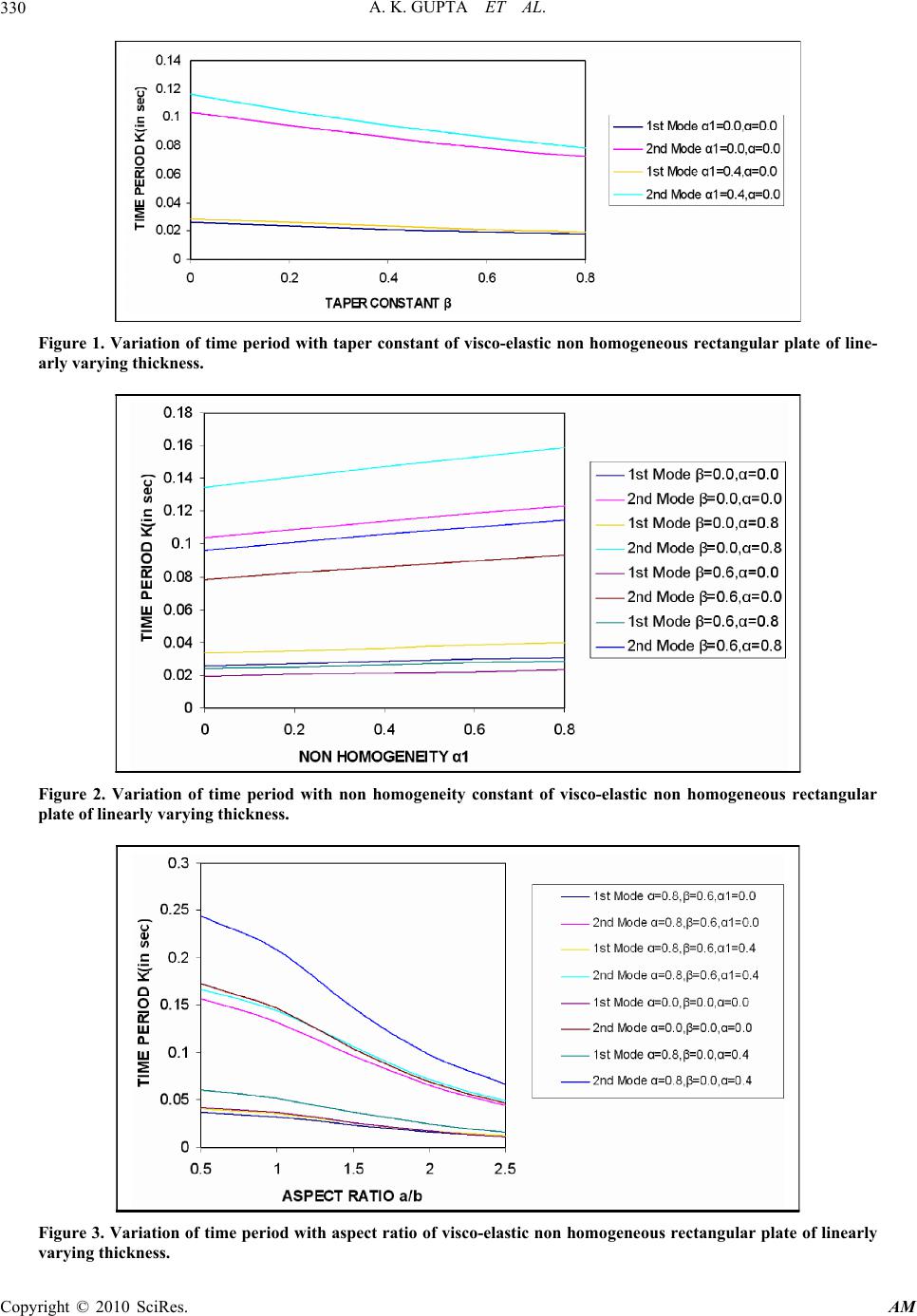 A. K. GUPTA ET AL. Copyright © 2010 SciRes. AM 330 Figure 1. Variation of time period with taper constant of visco-elastic non homogeneous rectangular plate of line- arly varying thickness. Figure 2. Variation of time period with non homogeneity constant of visco-elastic non homogeneous rectangular plate of linearly varying thickness. Figure 3. Variation of time period with aspect ratio of visco-elastic non homogeneous rectangular plate of linearly varying thickness. 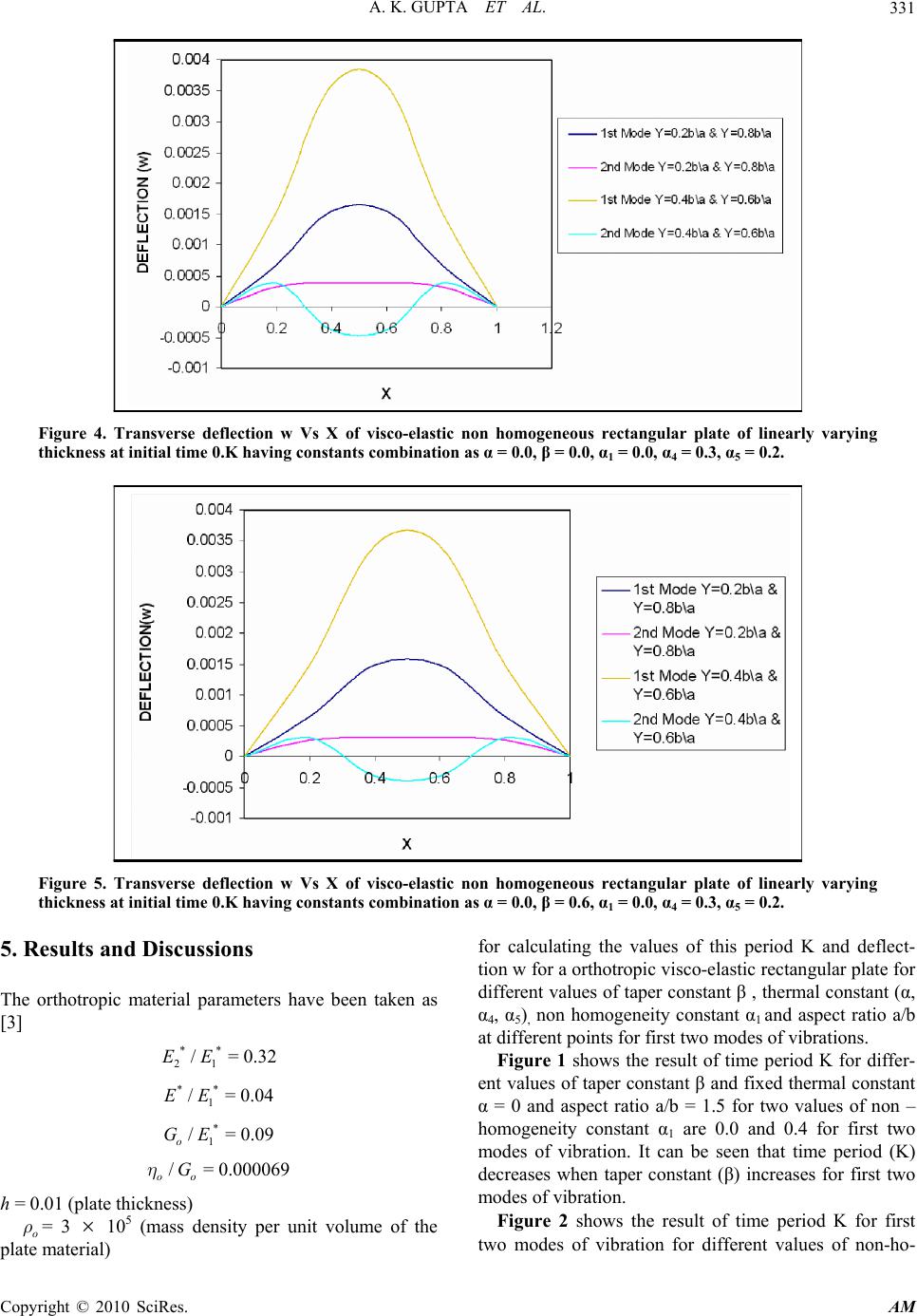 A. K. GUPTA ET AL. Copyright © 2010 SciRes. AM 331 Figure 4. Transverse deflection w Vs X of visco-elastic non homogeneous rectangular plate of linearly varying thickness at initial time 0.K having constants combination as α = 0.0, β = 0.0, α1 = 0.0, α4 = 0.3, α5 = 0.2. Figure 5. Transverse deflection w Vs X of visco-elastic non homogeneous rectangular plate of linearly varying thickness at initial time 0.K having constants combination as α = 0.0, β = 0.6, α1 = 0.0, α4 = 0.3, α5 = 0.2. 5. Results and Discussions The orthotropic material parameters have been taken as [3] ** 21 /=0.32EE ** 1 /=0.04EE * 1 /=0.09 o GE /= 0.000069 oo Gh h = 0.01 (plate thickness) o r= 3 105 (mass density per unit volume of the plate material) for calculating the values of this period K and deflect- tion w for a orthotropic visco-elastic rectangular plate for different values of taper constant β , thermal constant (α, α4, α5), non homogeneity constant α1 and aspect ratio a/b at different points for first two modes of vibrations. Figure 1 shows the result of time period K for differ- ent values of taper constant β and fixed thermal constant α = 0 and aspect ratio a/b = 1.5 for two values of non – homogeneity constant α1 are 0.0 and 0.4 for first two modes of vibration. It can be seen that time period (K) decreases when taper constant (β) increases for first two modes of vibration. Figure 2 shows the result of time period K for first two modes of vibration for different values of non-ho- 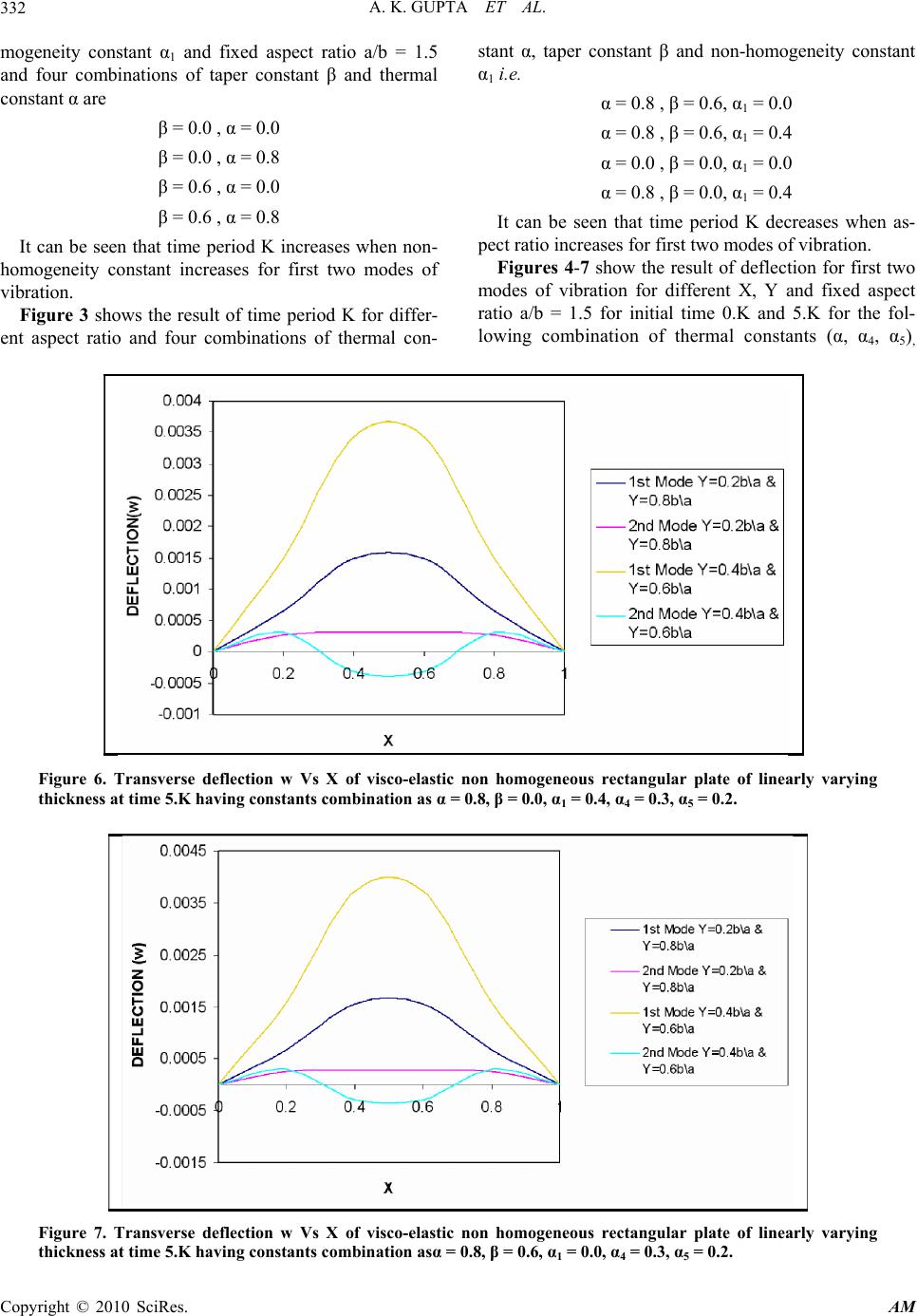 A. K. GUPTA ET AL. Copyright © 2010 SciRes. AM 332 mogeneity constant α1 and fixed aspect ratio a/b = 1.5 and four combinations of taper constant β and thermal constant α are β = 0.0 , α = 0.0 β = 0.0 , α = 0.8 β = 0.6 , α = 0.0 β = 0.6 , α = 0.8 It can be seen that time period K increases when non- homogeneity constant increases for first two modes of vibration. Figure 3 shows the result of time period K for differ- ent aspect ratio and four combinations of thermal con- stant α, taper constant β and non-homogeneity constant α1 i.e. α = 0.8 , β = 0.6, α1 = 0.0 α = 0.8 , β = 0.6, α1 = 0.4 α = 0.0 , β = 0.0, α1 = 0.0 α = 0.8 , β = 0.0, α1 = 0.4 It can be seen that time period K decreases when as- pect ratio increases for first two modes of vibration. Figures 4-7 show the result of deflection for first two modes of vibration for different X, Y and fixed aspect ratio a/b = 1.5 for initial time 0.K and 5.K for the fol- lowing combination of thermal constants (α, α4, α5), Figure 6. Transverse deflection w Vs X of visco-elastic non homogeneous rectangular plate of linearly varying thickness at time 5.K having constants combination as α = 0.8, β = 0.0, α1 = 0.4, α4 = 0.3, α5 = 0.2. Figure 7. Transverse deflection w Vs X of visco-elastic non homogeneous rectangular plate of linearly varying thickness at time 5.K having constants combination asα = 0.8, β = 0.6, α1 = 0.0, α4 = 0.3, α5 = 0.2. 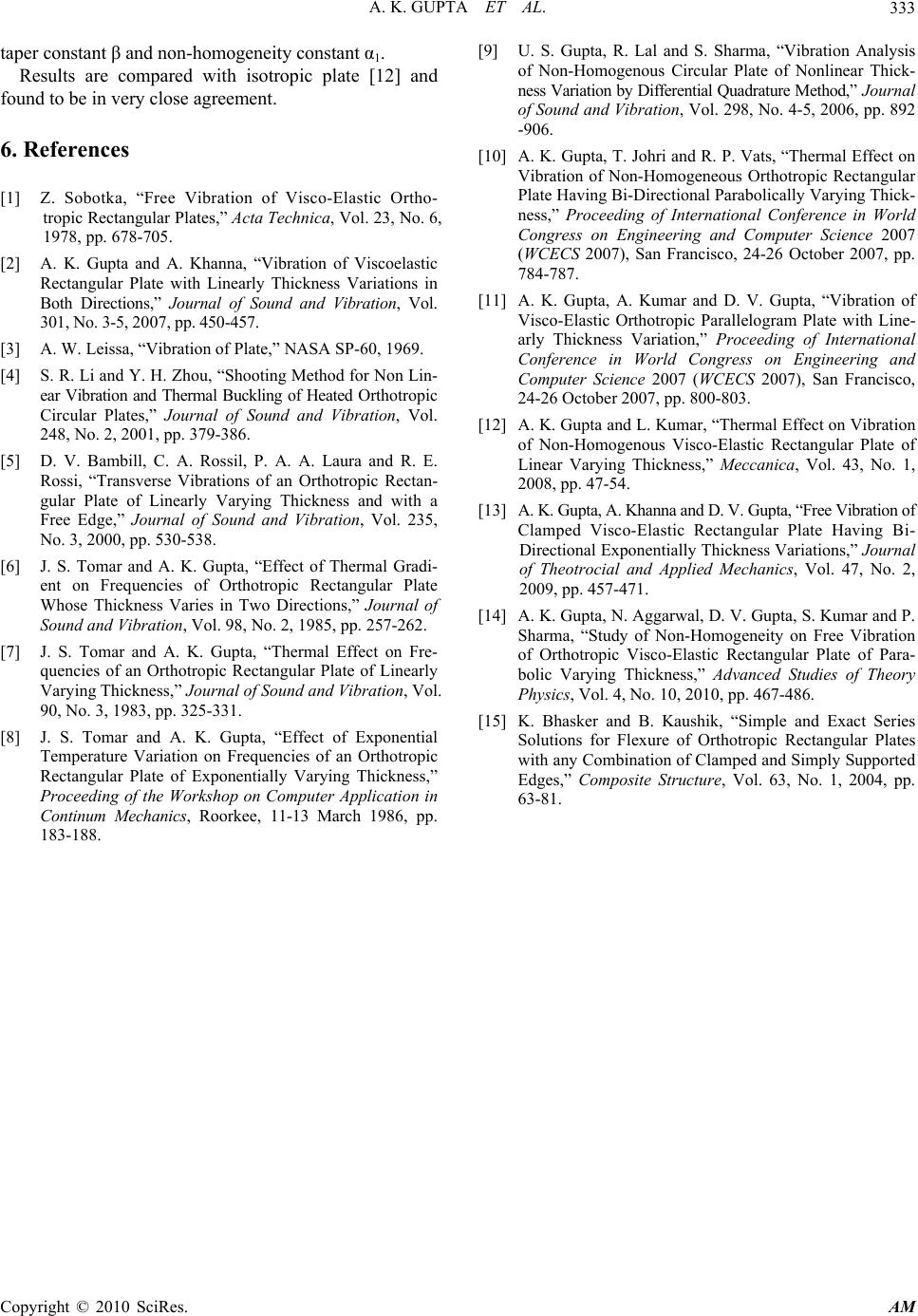 A. K. GUPTA ET AL. Copyright © 2010 SciRes. AM 333 taper constant β and non-homogeneity constant α1. Results are compared with isotropic plate [12] and found to be in very close agreement. 6. References [1] Z. Sobotka, “Free Vibration of Visco-Elastic Ortho- tropic Rectangular Plates,” Acta Technica, Vol. 23, No. 6, 1978, pp. 678-705. [2] A. K. Gupta and A. Khanna, “Vibration of Viscoelastic Rectangular Plate with Linearly Thickness Variations in Both Directions,” Journal of Sound and Vibration, Vol. 301, No. 3-5, 2007, pp. 450-457. [3] A. W. Leissa, “Vibration of Plate,” NASA SP-60, 1969. [4] S. R. Li and Y. H. Zhou, “Shooting Method for Non Lin- ear Vibration and Thermal Buckling of Heated Orthotropic Circular Plates,” Journal of Sound and Vibration, Vol. 248, No. 2, 2001, pp. 379-386. [5] D. V. Bambill, C. A. Rossil, P. A. A. Laura and R. E. Rossi, “Transverse Vibrations of an Orthotropic Rectan- gular Plate of Linearly Varying Thickness and with a Free Edge,” Journal of Sound and Vibration, Vol. 235, No. 3, 2000, pp. 530-538. [6] J. S. Tomar and A. K. Gupta, “Effect of Thermal Gradi- ent on Frequencies of Orthotropic Rectangular Plate Whose Thickness Varies in Two Directions,” Journal of Sound and Vibration, Vol. 98, No. 2, 1985, pp. 257-262. [7] J. S. Tomar and A. K. Gupta, “Thermal Effect on Fre- quencies of an Orthotropic Rectangular Plate of Linearly Varying Thickness,” Journal of Sound and Vibration, Vol. 90, No. 3, 1983, pp. 325-331. [8] J. S. Tomar and A. K. Gupta, “Effect of Exponential Temperature Variation on Frequencies of an Orthotropic Rectangular Plate of Exponentially Varying Thickness,” Proceeding of the Workshop on Computer Application in Continum Mechanics, Roorkee, 11-13 March 1986, pp. 183-188. [9] U. S. Gupta, R. Lal and S. Sharma, “Vibration Analysis of Non-Homogenous Circular Plate of Nonlinear Thick- ness Variation by Differential Quadrature Method,” Journal of Sound and Vibration, Vol. 298, No. 4-5, 2006, pp. 892 -906. [10] A. K. Gupta, T. Johri and R. P. Vats, “Thermal Effect on Vibration of Non-Homogeneous Orthotropic Rectangular Plate Having Bi-Directional Parabolically Varying Thick- ness,” Proceeding of International Conference in World Congress on Engineering and Computer Science 2007 (WCECS 2007), San Francisco, 24-26 October 2007, pp. 784-787. [11] A. K. Gupta, A. Kumar and D. V. Gupta, “Vibration of Visco-Elastic Orthotropic Parallelogram Plate with Line- arly Thickness Variation,” Proceeding of International Conference in World Congress on Engineering and Computer Science 2007 (WCECS 2007), San Francisco, 24-26 October 2007, pp. 800-803. [12] A. K. Gupta and L. Kumar, “Thermal Effect on Vibration of Non-Homogenous Visco-Elastic Rectangular Plate of Linear Varying Thickness,” Meccanica, Vol. 43, No. 1, 2008, pp. 47-54. [13] A. K. Gupta, A. Khanna and D. V. Gupta, “Free Vibration of Clamped Visco-Elastic Rectangular Plate Having Bi- Directional Exponentially Thickness Variations,” Journal of Theotrocial and Applied Mechanics, Vol. 47, No. 2, 2009, pp. 457-471. [14] A. K. Gupta, N. Aggarwal, D. V. Gupta, S. Kumar and P. Sharma, “Study of Non-Homogeneity on Free Vibration of Orthotropic Visco-Elastic Rectangular Plate of Para- bolic Varying Thickness,” Advanced Studies of Theory Physics, Vol. 4, No. 10, 2010, pp. 467-486. [15] K. Bhasker and B. Kaushik, “Simple and Exact Series Solutions for Flexure of Orthotropic Rectangular Plates with any Combination of Clamped and Simply Supported Edges,” Composite Structure, Vol. 63, No. 1, 2004, pp. 63-81. |

